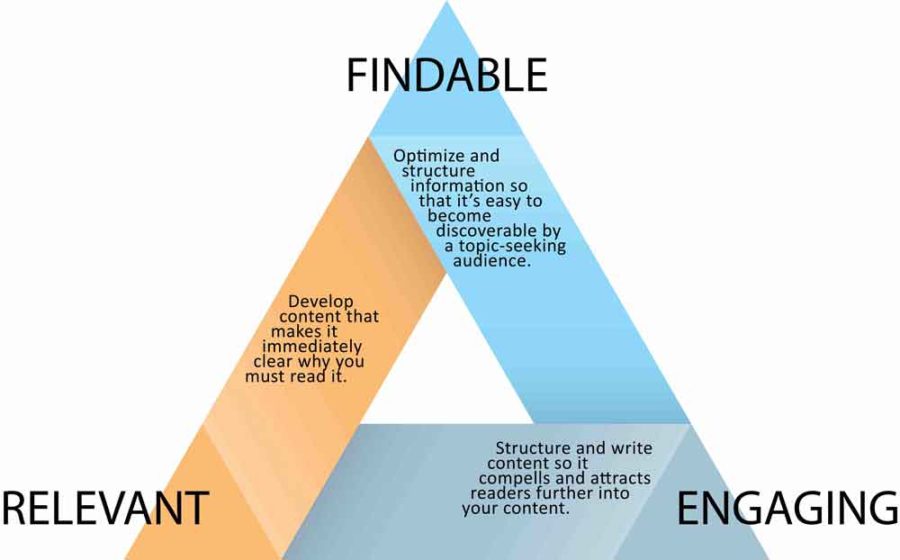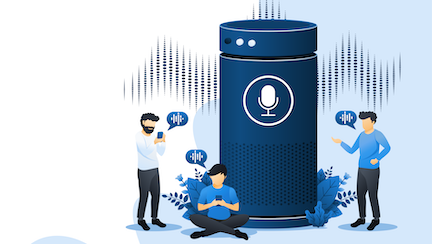
Content strategy: Three critical tips for killer content.
Content strategy is about creating and delivering content that satisfies your users.
That means content strategy is all about giving users the precise content they want, when they want it.
While there are different content strategy tools and best practices that are available to help you achieve this, when all is said and done, you will satisfy customers when you have content with these three critical components.
The content strategy sweet spot:
Being Findable. Engaging. Relevant.

Findable content.
Just as you don’t win the contests that you don’t show up to, no one is wowed or sold by content that doesn’t show up when they seek it. In other words, if they can’t find it, they can’t see it.
The best practices of content strategy should help you to research, create and structure content in ways that optimize information so that it becomes discoverable and attractive to your potential readers.
That means making your content findable to two different audiences.
For robots or “bots.”
These are the search engines and their automated content searching programs (spiders or bots) that scour and scan content on the web. You likely know the result of this process as search engine optimization (SEO). These bots collect information in your content about word use, links to other related content, subject matter authority, your URL and other factors in order to judge and rank how valuable your content is to topic-seeking users.
The higher that the bots assess the value of your content, the more likely users will find it through a search engine. If you want to be found, you must work to make your content SEO friendly.
For humans.
You must write content and structure the navigation of your content to please people. That means making it as interesting and as intuitive as possible. It must be cataloged as people think. That’s not always as logic would dictate.
If your content is placed into content containers that don’t seem appropriate (e.g., putting “about us” content in the photos navigation section, you make it harder to find the content they seek.
Relevant.
What every piece of content that you develop has to answer:
Why should I read this?
That’s relevancy. To answer it, have messaging and content that makes it clear why your user should invest their precious time and attention to engage it.
How to make it relevant.
Do your homework. This is where having marketing skills or an intricate understanding of your audience is really important. You must understand how your audience sees things in order to understand and create what matters to them. Think about:
- What are their needs?
- What kind of content would help satisfy or solve their problem?
- How can you talk about a seemingly distant topic in a way that connects with your audience?
Know and express that and you will have relevant content.
Engaging.
Vegetables are clearly good for you. Yet a lot of people don’t like to eat vegetables. Many of us might remember an experience where a good idea that we were so sure would be adopted and take off ended up being ignored and died in a meeting due to a boring, uninspiring presentation.
Good ideas are not always ideas that get read.
The key is to build content in a way that pulls the reader into your world of content. You must create content where users don’t feel as if they are being forced fed to consume it. You must craft your content to make it tempting and exciting in a way that they are pulled in and excited to learn more.
To be engaging ALWAYS ask yourself:
- What is in it for the reader? Why would he or she care about this information?
- Who are we talking to?
- How can we make the content satisfying and not overwhelming?
- Are we making our content easy to scan, consume, and understand?
- What tone or attitude would help to convey this message?
To write engaging content, remember:
- The average web user doesn’t “read” your content.
They skim, scan, and browse selectively. If they don’t quickly recognize useful, relevant content, they will often move on. If they do read, they pick up and collect short chunks of ideas and information that speak to their knowledge goal or task.
- Make content “scannable” and “snackable” to help readers catch and retain important ideas.
Reading from a computer screen is 25% slower than reading from paper.
Studies show that people are less likely to read long pieces of text on a webpage than in printed format.
- Be mindful of content that taxes the reader’s time.
Reserve longer copy for areas in which it is important for the reader to have a deeper level of information before taking an action. For these same reasons, it’s not optimal to simply post a print-designed document without adapting the content for the web.
When you create findable, relevant and engaging content, you deliver what you readers want most: satisfaction.
CONTENT STRATEGY CONSULTING
Content strategy is defining today’s successful business and leaving those too slow behind. Looking for more ideas and strategies around content marketing and delivering satisfying digital experiences for your brand, website or mobile application contact me for a free consultation.































